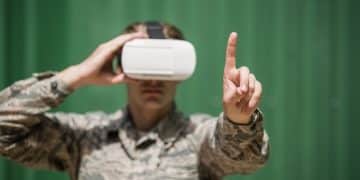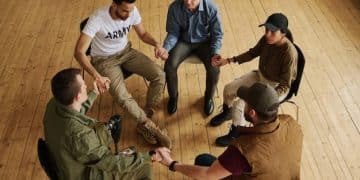US Military Gears Up for Arctic Conflicts: Strategies & Preparations
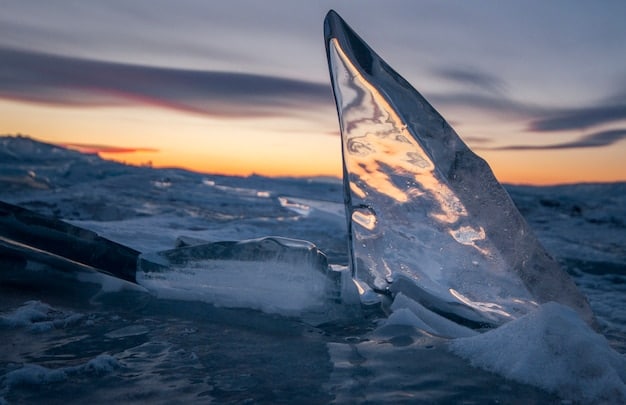
The US Military is bolstering its presence and capabilities in the Arctic to prepare for potential conflicts arising from increased accessibility and geopolitical competition in the region.
The Arctic region, once a remote and icy frontier, is rapidly transforming into a potential arena for geopolitical competition. As melting ice caps open up new shipping routes and access to valuable resources, the United States Military is actively preparing for potential conflicts in the Arctic. This involves strategic investments, advanced training, and collaborative efforts with allies to ensure a strong and capable presence. Learn how the US Military is preparing for potential conflicts in the Arctic Region.
Understanding the Emerging Arctic Security Landscape
The Arctic is no longer a frozen afterthought on the world stage. Climate change is accelerating the melting of ice, creating new opportunities and challenges. This has led to increased interest from various nations, including Russia and China, setting the stage for potential conflicts. Understanding this shifting landscape is crucial for the US Military’s preparedness.
The Geopolitical Significance of the Arctic
The Arctic’s strategic importance stems from its geographical location, its abundance of natural resources, and the opening of new sea routes. Control or influence over the Arctic could provide significant economic and military advantages.
Key Players in the Arctic Region
Several nations have a vested interest in the Arctic, including the United States, Russia, Canada, Denmark (Greenland), Norway, and others. Russia has been particularly assertive in recent years, increasing its military presence and infrastructure in the region.
- Russia’s military buildup in the Arctic poses a direct challenge to US interests.
- China’s economic and scientific activities are raising concerns about its long-term intentions.
- The US is working with allies to maintain a balance of power and protect its interests.
The US Military recognizes the need to adapt to the changing dynamics of the Arctic and is actively developing strategies to address potential threats and challenges. This includes modernizing its equipment, improving its training, and strengthening its partnerships with allies.
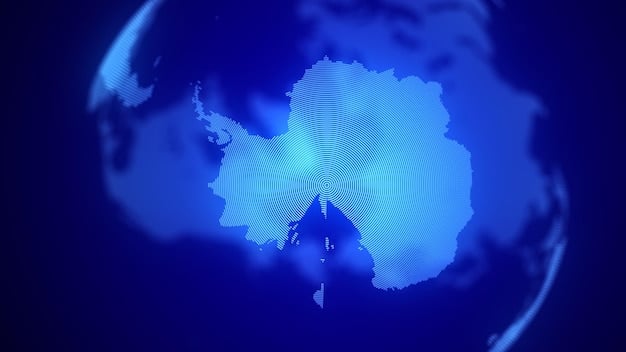
Enhancing Military Capabilities for Arctic Operations
To effectively operate in the Arctic, the US Military is investing in specialized equipment, training programs, and infrastructure improvements. These enhancements are designed to overcome the unique challenges posed by the Arctic environment.
Investing in Cold-Weather Equipment
Operating in extreme cold requires specialized equipment. The US Military is procuring and developing advanced cold-weather gear, including clothing, vehicles, and communication systems. These investments are critical for ensuring the safety and effectiveness of personnel.
Developing Specialized Training Programs
Arctic operations demand specialized training. The US Military is conducting exercises and simulations to prepare personnel for the challenges of operating in extreme cold, navigating icy terrain, and responding to emergencies in remote locations.
- The Army’s Cold Weather Training Center in Alaska provides realistic training scenarios.
- Joint exercises with allies enhance interoperability and readiness.
- Emphasis is placed on survival skills and adaptability in harsh conditions.
The US Military is also focusing on improving its logistics and supply chain capabilities to ensure that troops in the Arctic have the necessary resources to sustain operations. This includes establishing forward operating bases and prepositioning supplies in strategic locations.
Strengthening Alliances and Partnerships
The US Military recognizes that it cannot effectively address the challenges in the Arctic alone. Collaboration with allies and partners is essential for maintaining security and stability in the region.
NATO’s Role in Arctic Security
NATO plays a crucial role in coordinating military activities and enhancing security cooperation among member states in the Arctic. Joint exercises, intelligence sharing, and coordinated patrols are key components of NATO’s Arctic strategy.
Bilateral Agreements with Arctic Nations
The US has bilateral agreements with several Arctic nations, including Canada, Denmark, and Norway. These agreements facilitate military cooperation, information sharing, and joint training exercises. These partnerships are vital for maintaining a strong presence and responding to potential threats.
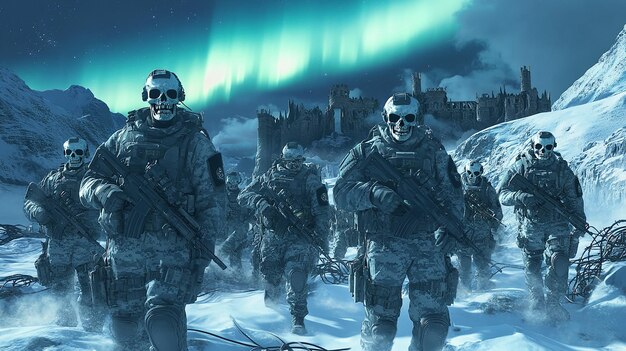
- Joint patrols with Canada enhance maritime domain awareness.
- Cooperation with Denmark ensures security in the Greenland area.
- Training exercises with Norway improve cold-weather combat capabilities.
The US is also working with non-Arctic nations that have an interest in the region, such as the United Kingdom and France, to promote a rules-based international order and ensure that the Arctic remains a zone of peace and cooperation.
Technological Advancements for Arctic Warfare
The US Military is leveraging technological advancements to enhance its capabilities in the Arctic. These include advanced surveillance systems, unmanned vehicles, and improved communication technologies.
Advanced Surveillance Systems
Maintaining situational awareness in the vast and remote Arctic region requires advanced surveillance systems. The US Military is deploying satellites, drones, and radar systems to monitor activity and detect potential threats. These systems provide critical intelligence for decision-making.
Unmanned Vehicles for Arctic Operations
Unmanned vehicles, both aerial and underwater, are playing an increasingly important role in Arctic operations. Drones can conduct reconnaissance and surveillance missions in hazardous environments, while underwater vehicles can map the seabed and detect underwater threats. These technologies reduce risk to personnel and enhance operational effectiveness.
- Drones provide real-time imagery and data in remote areas.
- Underwater vehicles can detect and track潛水艇.
- Autonomous systems enhance situational awareness and reduce response times.
Improved communication technologies are also essential for Arctic operations. The US Military is investing in satellite communication systems and high-frequency radios to ensure that troops can communicate effectively in remote and challenging environments. This includes developing secure and resilient communication networks that can withstand cyberattacks and other disruptions.
Addressing Environmental Considerations
The US Military recognizes the importance of protecting the fragile Arctic environment. Military activities must be conducted in a manner that minimizes environmental impact and respects the rights of indigenous communities.
Minimizing Environmental Impact
The US Military is implementing strict environmental protocols to minimize the impact of its activities on the Arctic ecosystem. This includes reducing pollution, protecting wildlife habitats, and preventing oil spills. The military is also investing in technologies that reduce its carbon footprint.
Engaging with Indigenous Communities
The US Military is committed to engaging with indigenous communities in the Arctic and respecting their traditional knowledge and cultural practices. This includes consulting with indigenous leaders on proposed military activities and incorporating their input into decision-making processes. The military also supports programs that promote environmental stewardship and cultural preservation.
- Consultations with indigenous leaders ensure that their concerns are addressed.
- Traditional knowledge is incorporated into environmental assessments.
- Support for programs that promote cultural preservation and environmental stewardship.
The US Military is also working to develop sustainable practices that will ensure the long-term health and resilience of the Arctic environment. This includes investing in renewable energy sources, promoting energy efficiency, and reducing waste.
Future Challenges and Opportunities
The Arctic region will continue to present significant challenges and opportunities for the US Military in the coming years. Adapting to climate change, managing increased competition, and protecting US interests will require sustained commitment and innovation.
Adapting to Climate Change
Climate change will continue to reshape the Arctic landscape, creating new challenges for military operations. The US Military must adapt to these changes by developing new strategies, technologies, and training programs. This includes preparing for increased maritime activity, managing the risks of thawing permafrost, and responding to extreme weather events.
Managing Increased Competition
Increased competition from Russia and China will continue to pose a challenge to US interests in the Arctic. The US Military must maintain a strong presence and work with allies to deter aggression and protect its interests. This includes enhancing its surveillance capabilities, strengthening its partnerships, and developing new strategies for managing conflict.
- Maintaining a strong presence deters aggression.
- Strengthening partnerships enhances collective security.
- Developing new strategies for managing conflict ensures stability.
The US Military must also be prepared to respond to a range of potential threats, including cyberattacks, disinformation campaigns, and terrorist activities. This requires investing in cybersecurity, enhancing intelligence capabilities, and working with law enforcement agencies to counter these threats.
| Key Area | Brief Description |
|---|---|
| ❄️ Cold Weather Gear | Specialized clothing and equipment for extreme Arctic conditions. |
| 🤝 Allied Partnerships | Collaborations with NATO and Arctic nations for security. |
| 🛰️ Surveillance Tech | Advanced systems for monitoring activity and threats. |
| 🛡️ Environmental Care | Efforts to minimize impact on the fragile Arctic ecosystem. |
Frequently Asked Questions
▼
Melting ice caps are opening new sea routes and access to resources, increasing geopolitical competition in the region and prompting military interest.
▼
The US Military is using specialized cold-weather gear, advanced surveillance systems, and unmanned vehicles designed for harsh Arctic conditions.
▼
Key allies include NATO members like Canada, Denmark, and Norway, with whom the US conducts joint exercises and shares information.
▼
Climate change necessitates adaptation through new strategies, technologies, and training to address the effects of melting ice and changing conditions.
▼
The US Military is implementing environmental protocols to minimize pollution, protect wildlife, and respect indigenous communities while conducting activities.
Conclusion
The US Military’s proactive approach to preparing for potential conflicts in the Arctic region reflects a growing understanding of the area’s strategic importance. By investing in specialized equipment, strengthening alliances, and leveraging technological advancements, the US aims to maintain a strong and capable presence in the Arctic, ensuring security and stability in this increasingly vital region.

